
A Thaos Swallowtail butterfly, also known as the King Swallowtail, photographed at REGUA, Brazil. Image credit: Chris Knowles.
“Flowers that fly and all but sing” – Robert Frost, 1923
Butterflies have been used in art for centuries, right back to Egyptian frescoes more than 3,500 years ago, and they have never lost their appeal, representing the beauty of nature. But butterflies are more than visually beautiful, they are valuable environmental indicators, for their rapid and sensitive responses to habitat and climate change.
Worldwide, there are known to be more than 18,000 species of butterfly, and they occur on all the Earth’s continents except Antarctica. Butterflies have been called ‘nature’s jewels’, but they are far more than pretty little insects. They are indispensable to successful farming, having immense economic value as pollinators. Globally, their value to agriculture per year is estimated at $200 billion, second only to the honeybee.
Swallowtail butterflies (in the family Papilionidae) include over 550 species, with wonderful names like birdwings, dragontails, apollos, peacocks, festoons, gorgons and kites. Birdwings are the world’s largest butterflies with wingspans of up to 5 inches. Unfortunately, swallowtails are among the most endangered of all butterflies and much in demand in international trade, collectors paying huge prices for protected species. Consequently they face a triple menace of habitat loss, climate change, and poaching. Thanks to conservation programmes and anti-poaching laws, swallowtails are surviving despite their black market value.
Although swallowtails are found mainly in hot and humid tropical areas, some occur as far north as Alaska and Norway, and as far south as Chile and Tasmania.
Celebrating swallowtails on postage stamps.
In May 1840 the UK launched the world’s first adhesive postage stamp used in a public postal system. Known as the Penny Black it featured a profile portrait of the young Queen Victoria. While most early stamps had images of reigning monarchs or coats of arms, in the twentieth century stamps began featuring a wider range of designs. On April 23, 1851 the Province of Canada issued its first stamp, known as the “Threepenny Beaver”, and this is considered to be the first official postage stamp to have an animal as its subject. Since then plants and animals have adorned postage stamps across the world.
Here are just a few swallowtail butterflies celebrated on postage stamps in the countries where WLT works with overseas conservation partners protecting vital habitat.
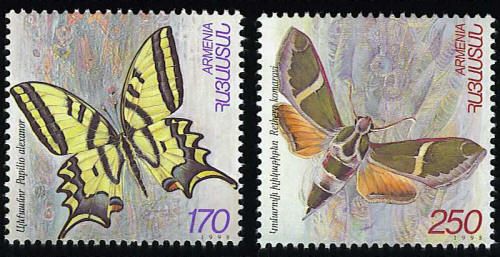
Armenia’s varied landscapes and habitats, ranging from flower-rich steppes, ancient forests, mountain gorges and alpine meadows, support a rich abundance of butterfly species, some of which have been featured on their postage stamps. WLT Partner: Foundation for the Preservation of Wildlife and Cultural Assets (FPWC).

A country fluttering with butterflies a full inventory has not yet been produced for Paraguay. So far 381 species have been recorded, of which 17 are swallowtails but expect this list to grow as more research takes place. WLT Partner: Guyra Paraguay.
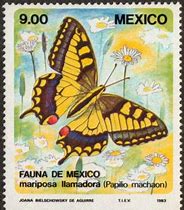
There are an astounding 2,045 butterfly species present in Mexico, of which 20 are swallowtails. Papilio machaon, the Old World swallowtail is also known as the Yellow Swallowtail or simply the Swallowtail as this species was the first to be given the name and is the type species of the genus Papilio. WLT Partner in Mexico: Grupo Ecológico Sierra Gorda (GSEG).
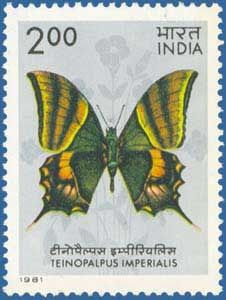
Swallowtails are represented by 89 species in India. The Kaiser-i-Hind (Teinopalpus imperialis) is a unique butterfly even among swallowtails, and originally occurred from Nepal and north India east to north Vietnam. In fragile ecosystems, like the Himalayas where the summers are short, the removal of a single species such as this could have a devastating chain effect. For instance, apple producers in the Himalayas complain of a decline in yield and quality due to the lack of insect pollinators, including butterflies and moths, in the flowering season. This Endangered species is listed on Appendix I of CITES and collecting is illegal. WLT Partner: Wildlife Trust of India (WTI).

Papilio memnon agenor, known as The Great Mormon is a large, mainly iridescent black swallowtail. It occurs widely in thirteen subspecies in different countries of South and Southeast Asia. WLT Partner in Malaysian Borneo: Hutan.
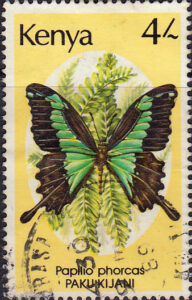
The Apple-green Swallowtail (Papilio phorcas) occurs in many parts of Africa. In Kenya it is found in secondary forest where its bright green and brown patterning provides excellent camouflage in the undergrowth. WLT Partner: Nature Kenya.

Zambia has an estimated 900 species of butterflies of which 19 are swallowtails. The African Moon Moth, with its long ‘tails’ is, in fact, a giant silk moth of the family Saturniidae. It occurs widely in Eastern and South Africa. Apart from the eye-like markings on its wings, the colouring and shape of the wings resemble a piece of foliage and the tails look like a dried leaf stem, providing excellent camouflage. WLT Partner in Zambia: Kasanka Trust.
More information – To see a full list of butterflies featured on stamps from all countries, please click here.
WLT Partners saving land for swallowtails
Although a small country (a bit smaller than Belgium), Armenia supports more than 230 species of butterfly, among them Caucasian specialities as well as many European and Asiatic species at the edge of their range. Each of Armenia’s varied landscapes, which include semi-desert, flower-rich steppes, ancient forests, mountain gorges and alpine meadows, provides habitat for a distinct butterfly community.
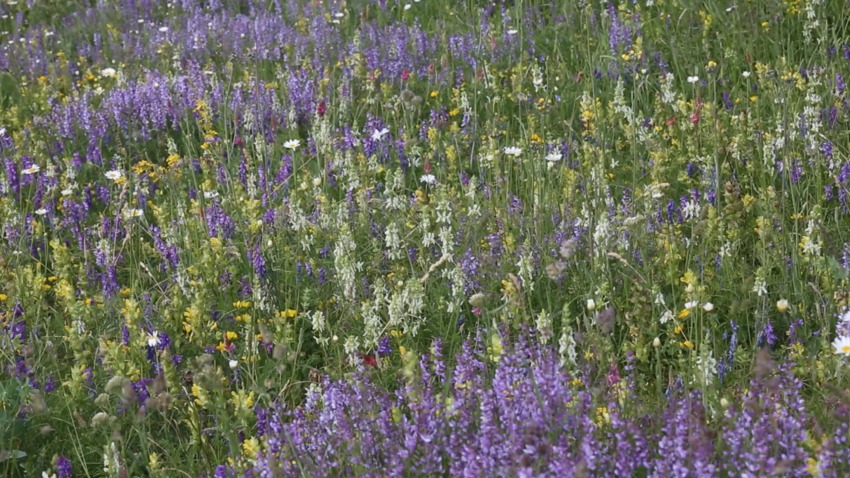
Armenia’s flower rich meadows are often referred to as ‘Little Switzerland’. The are alive with butterflies. WLT Partner in Armenia: Foundation for the Preservation of Wildlife and Culture (FPWC). Image credit: © David Bebber
Saving habitats for butterflies
Butterflies are good indicators of the health of an ecosystem – an environment where butterflies are plentiful would also be fertile for the growth of plants and serve as a suitable habitat for other animals. Butterflies are found at the bottom of the food chain, making them an important food source for many birds and mice. This means that when the butterfly population suffers, so does everything else above it – creating a “butterfly effect”. Interestingly, nearly two thirds of all invertebrate species can be linked back to the butterfly via the food chain. This is why scientists fear that if the butterfly were to disappear, it could cause the collapse of the much of the ecosystems that we need. By saving threatened habitats across the world, WLT conservation partners are playing a vital role in protecting the web of life.
Suggested reading:
Rainbow Dust, Three Centuries of Delight in British Butterflies – by Peter Marren.
Wildlife writer and journalist, Peter Marren, is an authority on invertebrate folklore and names and Rainbow Dust is far from being just another natural history of butterflies. With a lifetime’s obsession with butterflies the author explores the ways in which butterflies delight and inspire us all, naturalists and non-naturalists alike. In this uniquely eloquent and deeply personal book, full of wit and insight as well as surprising facts about some of the butterfly hunters of the past. It is highly recommended reading.
Safeguarding land is a challenge; successfully protecting large areas of land is an arduous, unpredictable and precarious one. The on-going reserve management that each of our Keepers of the Wild provides relieves this pressure, facilitating far better care for these beautiful but vulnerable habitats and the species which rely on them.
Find out more about the Keepers of the Wild
A one-off donation of £5,000 will sponsor a reserve ranger for a year, and companies and individuals who donate £5,000 receive regular field reports from the ranger.
But every donation, no matter how small, helps rangers carry out their essential duties to protect threatened habitats and species.
